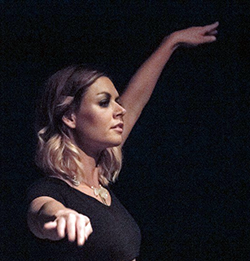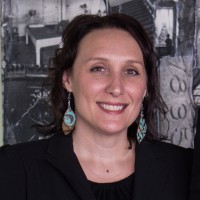Views from the field
We asked a group of transportation professionals, artists, and arts administrators who have successfully worked at the intersection of the arts and transportation for their advice on how to advocate for this type of collaboration, and how to talk about the benefits of this interdisciplinary work.
“I think artists… inherently have the same skills [as project managers], maybe even elevated in a lot of ways because they work alone, and they don’t have a support system of a city government or other layers of government to help. Artists are a model for what our…project managers across the board could and should maybe be thinking about in terms of problem solving, in terms of stepping back to think about the process of questioning the frameworks that we’ve always worked in.”

Eric Asboe
Transportation Administrative Manager, Chattanooga Department of Transportation
“A lot of folks who haven’t had the experience of commissioning public art may not understand the full cost of this type of work… To actually be creating durable public art that has a community-based process and will be able to withstand the elements, and especially the extremely harsh elements of cars driving on top of it, it doesn’t cost what people typically expect. I think there’s kind of a gray zone where there’s a lot of really cool placemaking and tactical urbanism projects that are created as labors of love. … [They’re] being created by neighbors who are just trying to solve their own problems. And that’s something that we celebrate and it’s often a narrative that is upheld, which is look at what these neighbors did: they had a problem and they just went out there and fixed it on their own—and they only spent $300 on paint. And in some cases, that’s true, but it doesn’t reflect the sweat equity that goes into these types of projects.”

Graham Coreil-Allen
Artist, Graham Projects
“I think people get wrapped up in artists’ products—they see dance, or they see painting—and they don’t understand the value an artist brings is actually their ability to create a process that is about creative problem solving. Artists have invested in creative problem solving as a daily practice. … [They’re] being created by neighbors who are just trying to solve their own problems. And that’s something that we celebrate and it’s often a narrative that is upheld, which is look at what these neighbors did: they had a problem and they just went out there and fixed it on their own—and they only spent $300 on paint. And in some cases, that’s true, but it doesn’t reflect the sweat equity that goes into these types of projects.”

Jules Downum
Artist-in-Residence, Chattanooga Department of Transportation
“One of the most valuable returns for a transit agency from working with artists is the opportunity that art creates to engage with the public whether they use transit or not. Public art gives us a chance to tell the agency’s story to the community without necessarily talking about transit. The artworks create a sense of public ownership and make our properties more visibly a part of the city we serve.”
“Arts administrators play an important role in advocating for the artist and the project with the agency, as well as making sure the transit agency’s goals and considerations are met. From the artist’s perspective, having someone ‘on the inside’ who understands their perspective and can shepherd them and their project through the bureaucracy is paramount.”

Katherine Dirga
Director, Artbound, Metropolitan Atlanta Rapid Transit Authority
“Successful transit is more than the on-time running of trains, planes, and buses. It is critical infrastructure that must become integrated to place. Transit carries people, and people are not homogenous or monolithic. Transit is in communities—and we need to engage and understand those communities for transit to be its most successful.
“To bring artists into dialogue on the functionality of transit is to have the best combination of focus-group and consultant possible. They want the agency to succeed, and are active listeners and keen problem solvers. Every aspect of every transit agency impacts the riders and the surrounding communities. If we can optimize that outcome with artists, transit is on a better path to long-term success.”

Jennifer Easton
Art Program Manager, Bay Area Rapid Transit
“Art brings public attention and involvement to transportation projects [and] makes community engagement easier.”

Sam Krassenstein
Transportation and Infrastructure Advisor, City of Detroit
“Discuss the arts as integral to solving transportation challenges in creative ways (rather than an add on).”
“Think of these projects as creating design precedents—enter the work with structure and intention.”
“Work with allies outside of arts disciplines and make sure their voices come forward.
“Use the language of the folks you are in conversation with—understand their needs, language, and culture of communication.”
“Discuss (and compensate) the arts as the distinct professional discipline that it is.”
“When possible, use existing data to illustrate the need for what you are proposing.
“Propose projects with a customer focus and collect feedback from customers that demonstrates effectiveness.”
“Start with a low-hanging-fruit proposition that is relatable and can be a stepping stone.
“Celebrate collaborative accomplishments, ensure all participants are credited and lauded, and build from there.”
“Artists can help “leverage the commitments of neighborhoods near the transportation project—[transportation professionals] are often interested in integrating transportation and land use planning, and may want to engage in ‘creative placemaking’ to achieve their goals. [Artists’] involvement can often increase support for the project.”
Los Angeles Metro’s Arts & Design Group
“Artists can see space and materials in a unique way as their brains work in a different way… Artists are problem solvers who use their physical and emotional reactions to a space or project to come up with creative ways to engage the community. ”

Naomi RaMona Schliesman
Artist
“The best way to convince an arts administrator or an engineer to include an artist on a transportation project is to show outstanding projects that have been conceived, designed, and implemented within the parameters and budgets associated with what normally would be ‘formulaic’ infrastructure. Artists bring creative dialogue and new perspectives to the ‘same old, same old.’”
“The best way to ‘sell’ vision is to show ‘vision’ and to define a process that promotes expansive thinking and awareness, by engaging all players and stakeholders. Design team collaboration is one of the best ways to involve artists in infrastructure, expanding early conversations at the project start, advocating for the importance of human scale, environmental awareness, connection to place, and community engagement.”

Vicki Scuri
Artist/Transportation Specialist
“Focusing on safety generally speaks well to engineers. Also, acknowledging there are reasons for engineers to be conservative in changing their long-held practices (beyond just being stubborn) helps. Remember the courts protect engineers who follow the rules and oftentimes punish those who try new things.”

Scott Zainhofsky
Planning/Asset Management Division Director, North Dakota Department of Transportation
This text originally appeared in Forecast FORWARD Issue 2: Transportation.
